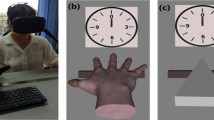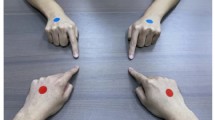Abstract
Previous rubber/virtual hand illusion studies have established important constraints for the illusion that an artificial effector becomes part of one’s own body (perceived ownership), and that its actions are being caused by oneself (perceived agency). We can take these observed constraints to establish two of three Wegner’s (Trends Cogn Sci 7:65–69; Wegner, Trends in Cognitive Sciences 7:65–69, 2003) criteria for the perception of personal agency: priority and consistency, but not Wegner’s third criterion—exclusivity. In this study we tested with virtual hand illusion, whether exclusivity (participant is certain who was controlling the virtual effector) can also be established. We manipulated two factors: exclusivity and consistency. Our results show that on both ownership and agency judgments, consistency and exclusivity produced main effects, and the two effects interacted in an underadditive fashion. Taken together, these findings provide support for our suggestion to extend Wegner’s agency theory to explain perceived body ownership, which in turn provides an integrative framework for interpreting constraints on ownership and agency illusions.


Similar content being viewed by others
References
Abdulkarim, Z., & Ehrsson, H. H. (2015). No causal link between changes in hand position sense and feeling of limb ownership in the rubber hand illusion. Attention Perception & Psychophysics, 78, 1–14.
Armel, K. C., & Ramachandran, V. S. (2003). Projecting sensations to external objects: Evidence from skin conductance response. Proceedings of the Royal Society of London, Series B: Biological Sciences, 270, 1499–1506.
Blakemore, S. J., Wolpert, D. M., & Frith, C. D. (2002). Abnormalities in the awareness of action. Trends in Cognitive Sciences, 6, 237–242.
Botvinick, M., & Cohen, J. (1998). Rubber hands’ feel’ touch that eyes see. Nature, 391, 756.
Caspar, E. A., De Beir, A., Magalhaes de Saldanha da Gama, P. A., Yernaux, F., Cleeremans, A., et al (2015). New frontiers in the rubber hand experiment: When a robotic hand becomes one’s own. Behavior Research Methods, 47, 744–755.
Costantini, M., & Haggard, P. (2007). The rubber hand illusion: Sensitivity and reference frame for body ownership. Consciousness and Cognition, 16, 229–240.
Frith, C. D., Blakemore, S. J., & Wolpert, D. M. (2000). Abnormalities in the awareness and control of action. Philosophical Transactions of the Royal Society of London B: Biological Sciences, 355, 1771–1788.
Gallagher, S. (2000a). Philosophical conceptions of the self: implications for cognitive science. Trends in Cognitive Sciences, 4, 14–21.
Gallagher, S. (2000b). Self-reference and schizophrenia: A cognitive model of immunity to error through misidentification. In D. Zahavi (Ed.), Exploring the self: Philosophical and psychopathological perspectives on self-experience (pp. 203–239). Amsterdam & Philadelphia: John Benjamins.
Holmes, N. P., Snijders, H. J., & Spence, C. (2006). Reaching with alien limbs: Visual exposure to prosthetic hands in amirror biases proprioception without accompanying illusions of ownership. Perception and Psychophysics, 68, 685–701.
Hommel, B. (2009). Conscious and unconscious control of spatial action. In W. P. Banks (Ed.), Encyclopedia of consciousness (pp. 171–181). Oxford: Elsevier.
Kalckert, A., & Ehrsson, H. H. (2012). Moving a rubber hand that feels like your own: A dissociation of ownership and agency. Frontiers in Human Neuroscience, 6, 40.
Kalckert, A., & Ehrsson, H. H. (2014a). The moving rubber hand illusion revisited: Comparing movement and visuotactile stimulation to induce illusory ownership. Consciousness and Cognition, 26, 117–132.
Kalckert, A., & Ehrsson, H. H. (2014b). The spatial distance rule in the moving and classical rubber hand illusions. Consciousness and Cognition, 30, 118–132.
Kokkinara, E., & Slater, M. (2014). Measuring the effects through time of the influence of visuomotor and visuotactile synchronous stimulation on a virtual body ownership illusion. Perception, 43, 43–58.
Liepelt, R., Dolk, T., & Hommel, B. (2017). Self-perception beyond the body: the role of past agency. Psychological Research Psychologische Forschung, 81, 549–559.
Lloyd, D. M. (2007). Spatial limits on referred touch to an alien limb may reflect boundaries of visuo-tactile peripersonal space surrounding the hand. Brain and Cognition, 64, 104–109.
Ma, K., & Hommel, B. (2013). The virtual-hand illusion: Effects of impact and threat on perceived ownership and affective resonance. Frontiers in Psychology, 4, 604.
Ma, K., & Hommel, B. (2015a). Body-ownership for actively operated non-corporeal objects. Consciousness and Cognition, 36, 75–86.
Ma, K., & Hommel, B. (2015b). The role of agency for perceived ownership in the virtual hand illusion. Consciousness and Cognition, 36, 277–288.
Maravita, A., Spence, C., & Driver, J. (2003). Multisensory integration and the body schema: Close to hand and within reach. Current Biology, 13, R531–R539.
Michotte, A. (1946/1963). La Perception de la Causalite, 1946. Louvain: Institut Superieur de Philosophie. (English translation by T. Miles & E. Miles, The perception of causality, Basic Books, 1963).
Obhi, S. S., & Hall, P. (2011). Sense of agency and intentional binding in joint action. Experimental Brain Research, 211, 655–662.
Preston, C. (2013). The role of distance from the body and distance from the real hand in ownership and disownership during the rubber hand illusion. Acta Psychologica, 142, 177–183.
Rohde, M., Di Luca, M., & Ernst, M. O. (2011). The rubber hand illusion: Feeling of ownership and proprioceptive drift do not go hand in hand. PLoS One, 6(6), e21659.
Sanchez-Vives, M. V., Spanlang, B., Frisoli, A., Bergamasco, M., & Slater, M. (2010). Virtual hand illusion induced by visuomotor correlations. PLoS One, 5, e10381.
Shin, Y. K., Proctor, R. W., & Capaldi, E. J. (2010). A review of contemporary ideomotor theory. Psychological Bulletin, 136, 943–974.
Short, F., & Ward, R. (2009). Virtual limbs and body space: Critical features for the distinction between body space and near-body space. Journal of Experimental Psychology: Human Perception and Performance, 35, 1092–1103.
Slater, M., Perez-Marcos, D., Ehrsson, H. H., & Sanchez-Vives, M. V. (2008). Towards a digital body: The virtual arm illusion. Frontiers in Human Neuroscience, 2, 6.
Synofzik, M., Vosgerau, G., & Newen, A. (2008). Beyond the comparator model: A multifactorial two-step account of agency. Consciousness and Cognition, 17, 219–239.
Tsakiris, M., Carpenter, L., James, D., & Fotopoulou, A. (2010). Hands only illusion: Multisensory integration elicits sense of ownership for body parts but not for non-corporeal objects. Experimental Brain Research, 204, 343–352.
Tsakiris, M., & Haggard, P. (2005). The rubber hand illusion revisited: Visuotactile integration and self-attribution. Journal of Experimental Psychology: Human Perception and Performance, 31, 80–91.
Tsakiris, M., Prabhu, G., & Haggard, P. (2006). Having a body versus moving your body: How agency structures body-ownership. Consciousness and Cognition, 15, 423–432.
Tsakiris, M., Schütz-Bosbach, S., & Gallagher, S. (2007). On agency and body ownership: Phenomenological and neurocognitive reflections. Consciousness & Cognition, 16, 645–660.
Wegner, D. M. (2003). The mind’s best trick: how we experience conscious will. Trends in Cognitive Sciences, 7, 65–69.
Wegner, D. M., Sparrow, B., & Winerman, L. (2004). Vicarious agency: experiencing control over the movement of others. Journal of Personality & Social Psychology, 86, 838–848.
Wegner, D. M., & Wheatley, T. (1999). Apparent mental causation: sources of the experience of will. American Psychologist, 54, 480–492.
Zhang, J., Ma, K., & Hommel, B. (2015). The virtual hand illusion is moderated by context-induced spatial reference frames. Frontiers in Psychology, 6, 1659.
Author information
Authors and Affiliations
Contributions
KM and BH developed the study concept. All authors contributed to the study design. Testing and data collection were performed by KM. Data analyses were performed by KM and BH. KM drafted the manuscript, and BH and HC provided critical revisions. All authors approved the final version of the manuscript for submission. We would like to thank two anonymous reviewers for their suggestions.
Corresponding authors
Ethics declarations
Funding
This research was supported by National Natural Science Foundation of China (31700942), China Postdoctoral Science Foundation (2017M622936), Chongqing Postdoctoral Science Foundation (Xm2017066), and Fundamental Research Funds for the Chinese Central Universities (SWU116055) to K. M. in China, and an infrastructure grant of the Netherlands Research organization (NWO) to B. H.
Conflict of interest
The authors declared that they had no conflicts of interest with respect to their authorship or the publication of this article.
Ethical standards
All procedures performed in this study were in accordance with the ethical standards of ethics committee in Southwest University and with the 1964 Helsinki declaration and its later amendments.
Informed consent
Informed consents were obtained from all participants included in this study.
Rights and permissions
About this article
Cite this article
Ma, K., Hommel, B. & Chen, H. The roles of consistency and exclusivity in perceiving body ownership and agency. Psychological Research 83, 175–184 (2019). https://doi.org/10.1007/s00426-018-0978-7
Received:
Accepted:
Published:
Issue Date:
DOI: https://doi.org/10.1007/s00426-018-0978-7




